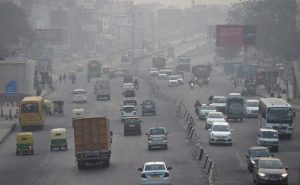Transport Air Pollution
Transport Air Pollution
Vehicular pollution is the introduction of harmful materials into the environment by motor vehicles. These are the materials, known as pollutants, have several bad effects on human health and the ecosystem.
Air pollution is caused by the solid and liquid particles and certain gases that are suspended in the air. These particles and gases can be come from car and truck exhaust, factories, dust, pollen, mold spores, volcanoes and wildfires. The solid and liquid particles suspended in our air is called aerosols.
Environmental Effects of Transport
The environmental effects of transport are significant because transport is a major user of energy, and burns most of the world’s petroleum. This creates of air pollution, including nitrous oxides and particulates, and is a significant contributor to global warming through the emission of carbon dioxide.

Transport Air Pollution
Admittedly, the air transport is extremely polluting but so are cars. Air traffic represents less than 2-3% of the global CO2 emissions whereas road traffic accounts for around 10% of these direct emissions. Still, plane remains among the most polluting means of transport, together with cars.
The movements of pollutants in the atmosphere is caused by transport, dispersion, and deposition. Transport are movement caused by a time averaged wind flows. Dispersion results from the local turbulence, that is, motions that last less than the time used to average the transport.
Transport Air Pollution
Transport also leads to releases of pollutants, which can be spread beyond the reach of transport networks. They can be contributing to background concentrations of particulate matter, ozone and nitrogen dioxide, affecting people, plants and animals.
The transportation sector generates the largest share of greenhouse gas emissions. Greenhouse gas emissions from transportation primarily comes from burning fossil fuel for our cars, trucks, ships, trains, and planes.
Passenger vehicles are the major pollution contributor, producing significant amounts of nitrogen oxides, carbon monoxide, and other pollution. In 2013, transportation contributed more than half of the carbon monoxide and nitrogen oxides, and almost a quarter of the hydrocarbons emitted into our air.
Rail transportation emits about 0.2 pounds of greenhouse gases per passenger mile (55 g/km) when each car is filled with 50 passengers
Reduce Pollution from Vehicles and Engines
- Drive less.
- Drive wise.
- Choose fuel efficient vehicles.
- Don’t idle.
- Optimize home deliveries.
- Use efficient lawn and gardening equipment.
Effects of Transport Air Pollution
Vehicle emissions contribute to the formation of ground level ozone (smog), which can be trigger health problems such as an aggravated asthma, reduced lung capacity, and increased susceptibility to respiratory illnesses, including pneumonia and bronchitis.
Total emissions are generally a function of the emission factors of each transport mode than their level of activity, which has implied a variety of impacts on the environment. These impacts fall within three categories,
-
Direct impacts:
The immediate consequences of transport activities on the environment where the cause and effect relationship are generally clear and well understood. For instance, noise and carbon monoxide emissions are known to have a direct harmful effects.
-
Indirect impacts:
The secondary effects of transport activities on environmental systems. They are often to the higher consequence than direct impacts, but the involved relationships are often misunderstood and more challenging to establish. For instance, particulates, which are mostly the outcome of incomplete combustion in an internal combustion engine, are indirectly linked with a respiratory and cardiovascular problems since they contribute, among other factors, to such a conditions.
-
Cumulative impacts:
The additive, multiplicative or synergetic consequences of transport activities. They consider as the varied effects of direct and indirect impacts on an ecosystem, which are often unpredictable. Climate changes, with complex causes and consequences, is the cumulative impact of several natural and anthropogenic factors, in which transportation plays a role. The shares of transportation in global, CO2 emissions is increasing. 22% of global CO2 emissions are attributed to the transport sectors, with this share is around 25% for advanced economies such as the United States.
https://www.apzem.com/india/products/product-categories.html

